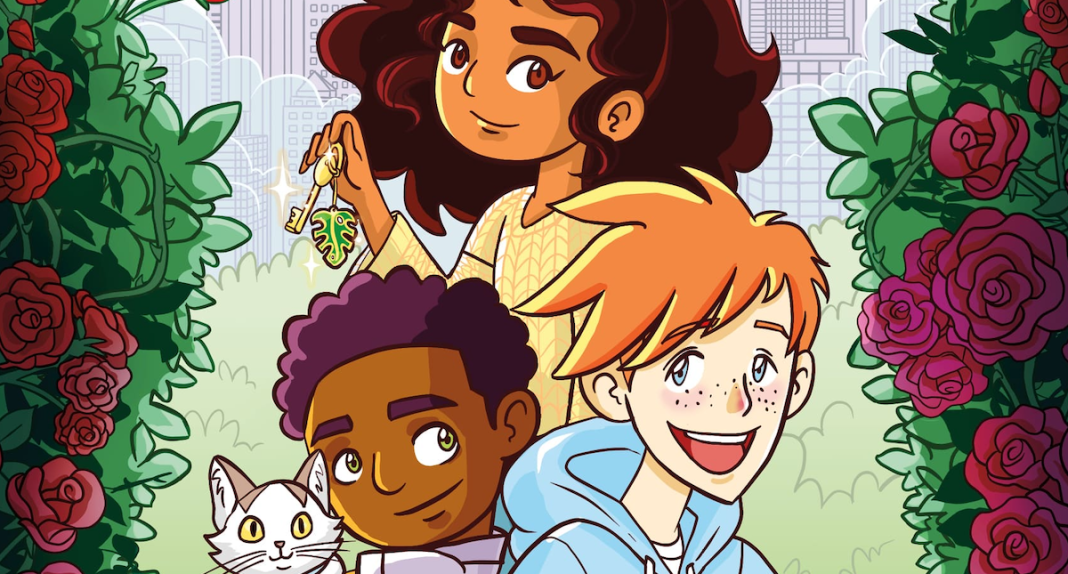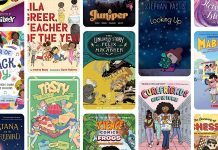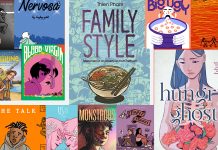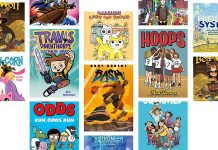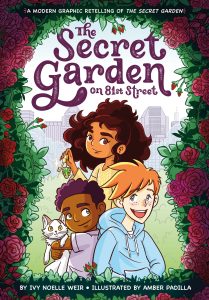
The Secret Garden on 81st Street by Ivy Noelle Weir and Amber Padilla, a new graphic novel adaptation of The Secret Garden by Frances Hodgson Burnett, will be available at your local bookstore or public library on October 19th, 2021, but today, The Beat is pleased to present an interview with the creators behind this new graphic adaptation.
The Beat caught up with Weir and Padilla over email to learn all about what went into adapting the novel on its 110th anniversary, to find out what challenges accompanied transporting the setting of the story to New York City, and to discover what went into finding the perfect aesthetic for all of the characters — including the surprising tricky Mrs. Medlock! Plus: how hard is it to draw so many plants?
AVERY KAPLAN: The Secret Garden on 81st Street is a graphic adaptation of the novel The Secret Garden by Frances Hodgson Burnett (celebrating its 110th anniversary this year). Did you have a relationship with The Secret Garden prior to this project?
IVY NOELLE WEIR: I read the book as a kid, but I was especially obsessed with the 1993 film version. I watched it a ton of times and I even remember that they included a little promo locket with the VHS that I wore everywhere. So, I’ve always had a fondness for the story, and I was really excited at getting a chance to re-tell it!
AMBER PADILLA: Similar to Ivy I read the original novel when I was a kid and I was also a fan of the 90s film. I remember the story felt so surreal and magical but the deeper themes of the book sort of eluded me. Instead, I was quite obsessed with creating a Secret Garden of my own. I remember my parents bought me some wildflower seeds which I planted in the backyard. I also didn’t understand that wildflowers are kind of like weeds, so my Secret Garden got a little out of control.
KAPLAN: What went into the decision to set the story in present day New York City? Was this always the plan or did the decision take place at some time during the creative process?
WEIR: It was part of the original idea that our editor discussed with me when bringing me on to the project. I was really intrigued by the swap from country to city – in the original work, Mary experiences a total change of scenery going to this estate in the empty, misty moors, and there’s a very magical, fairytale quality to it. When I knew this version was going to be set in NYC, I wanted to capture some of that same feeling, that this was a totally new place for Mary and one full of secrets and magic and wonder.
PADILLA: While I didn’t play a part in the original decision to place the story in New York, I was really excited and intimidated by the prospect of tackling such an iconic setting. This was an especially formidable challenge since I was born and raised in California, and I’ve only been to New York twice in my life. Not to mention, the bulk of the work began during the pandemic so visiting the city wasn’t something I was able to do.
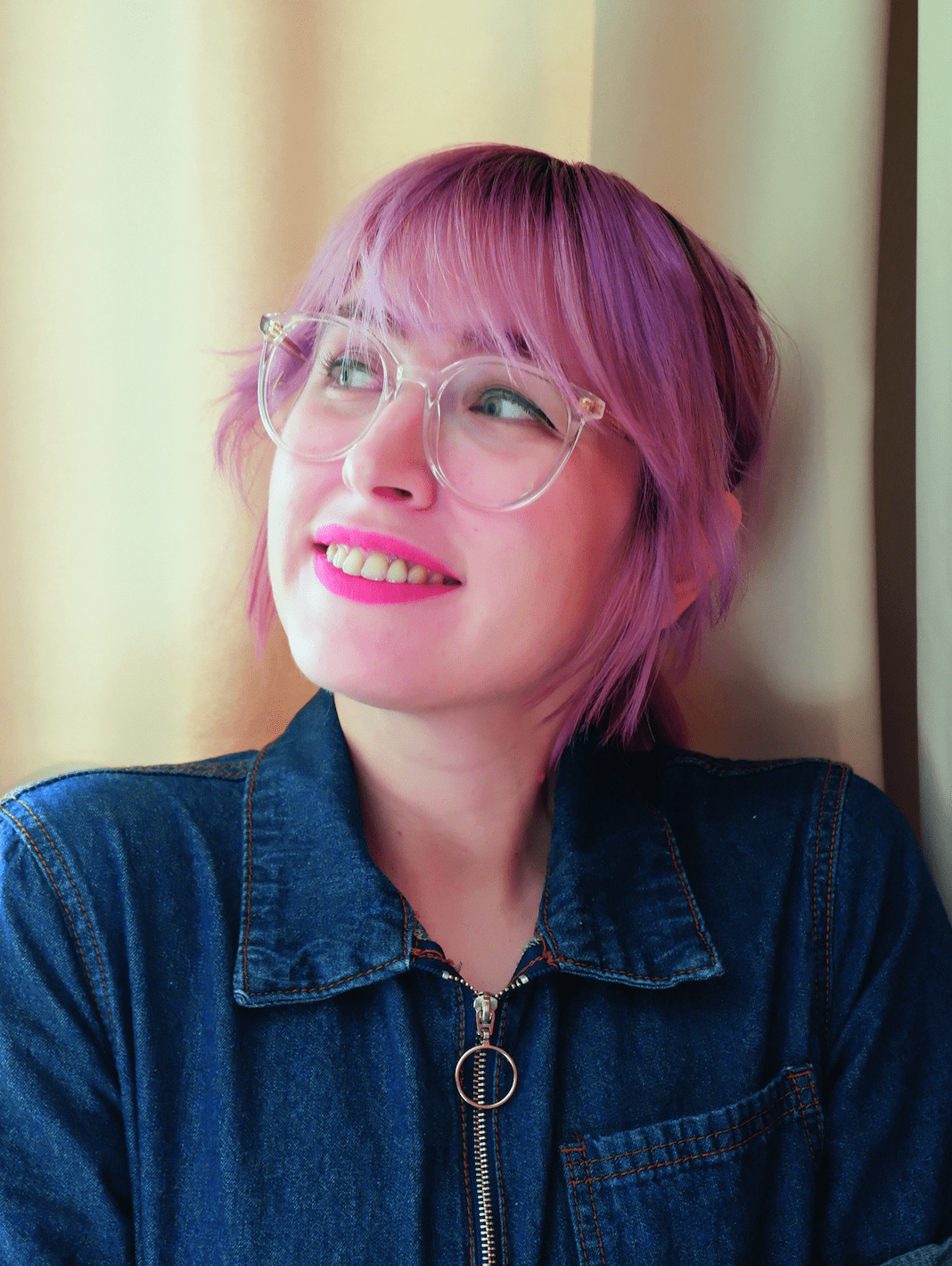
KAPLAN: What went into adapting The Secret Garden? How does writing an adaptation compare with writing an original graphic novel like Archival Quality? Was there any aspect of the adaptation that proved especially challenging?
WEIR: This was my first time adapting someone else’s work, so I was sort of learning as I went. I re-read the book, of course, and I rewatched the movie from the ‘90s that I had loved so much as a kid. It was easy for me to figure out what beats of the story I felt were really important and wanted to keep, that I felt were the real heart of the work and the thing that has made it timeless. Once I had those figured out, I was able to build off them to update the story for a modern audience and let our versions of Mary, Colin, and Dickon have their own adventure.
KAPLAN: When was the decision made to shift from a physical disability to a panic disorder? What went into this adaptation?
WEIR: Again, this was something that was suggested to me as part of my original discussion with my editor. If anyone is familiar with my previous work in Archival Quality, they know that mental health is something very personally important to me and something I explore in my writing. I have actually struggled with panic disorder myself since I was a young adult, and when we started talking about Colin living with anxiety, I thought this was a great opportunity to discuss it. In the original work, he’s suffering from a kind of vague Victorian malaise, and he’s miraculously kind of cured. I wanted this Colin’s struggles to be grounded in reality and to explore him receiving treatment, the care given to him by the people who love him, and also that fact that he’s not 100% “better” at the end, but he’s stronger, and he knows he is safe and cared for.
PADILLA: This was another decision that was made before I was brought onto the project but one that I was interested in engaging with. Shortly before I started work on this book, I read Raina Telgemeier’s Guts. I was impressed with how the book was able to broach the subject of mental health while making it incredibly accessible and enjoyable for a younger audience. When I read the script for The Secret Garden on 81st Street, I was blown away by Ivy’s care for the subject and her admiration and love for the characters. I was thrilled to be a part of that.
KAPLAN: Is there a relationship between Colin’s health, panic disorder, and family relationships? How did you set about addressing these complicated thematic concerns? Was it more difficult to adjust for a young reader’s perspective?
WEIR: When I was re-visiting the original work, I was struck by how much it is, really, about grieving. Mary, Lord Craven, and Colin have all lost people, and they’re sort of feeling their way through it and figuring out how to live when you’re grieving. Grief, unfortunately, doesn’t really know an age, and it’s something children experience too. I rooted myself in Mary’s perspective: What is like to be so young and experiencing so much change all at once? If I were her age again, and finding myself all alone in a new place, what would bring me comfort, what would intrigue me, what would be difficult? The biggest thing I try to bring when I write – for any age, really – is a sense of empathy, for the characters, for the potential readers. If I can make a book that brings a reader a small moment of feeling seen, I feel I have succeeded.
PADILLA: It was refreshing to work on the familiar aspects of the adaptation, particularly the relationship between Archie, his husband Masahiro and Colin. There’s no coming out story, there’s no doubt about their family, they’re just a family dealing with loss and grief and that was especially beautiful and touching to work on. I was excited for the opportunity to depict a queer multi-racial family dealing with these complicated issues. Representation matters, and I can only hope that this will have a positive impact in some small way.
KAPLAN: You’ve written both graphic novels and monthly serials (like the currently ongoing Bountiful Garden). How does writing a graphic novel compared with a monthly series (or is the process more similar that some might imagine)?
WEIR: With graphic novels, you have an entire seamless book to get from point A to point B, and pacing can be a little more languid. With single issues, you’ve got a month in between 20-ish page chunks of story, and you have to pace it so that people want to pick up the next issue and can follow the story even as it’s broken up. Bountiful Garden was my first monthly comic, and it was a definite learning curve, but a challenge I really enjoyed!
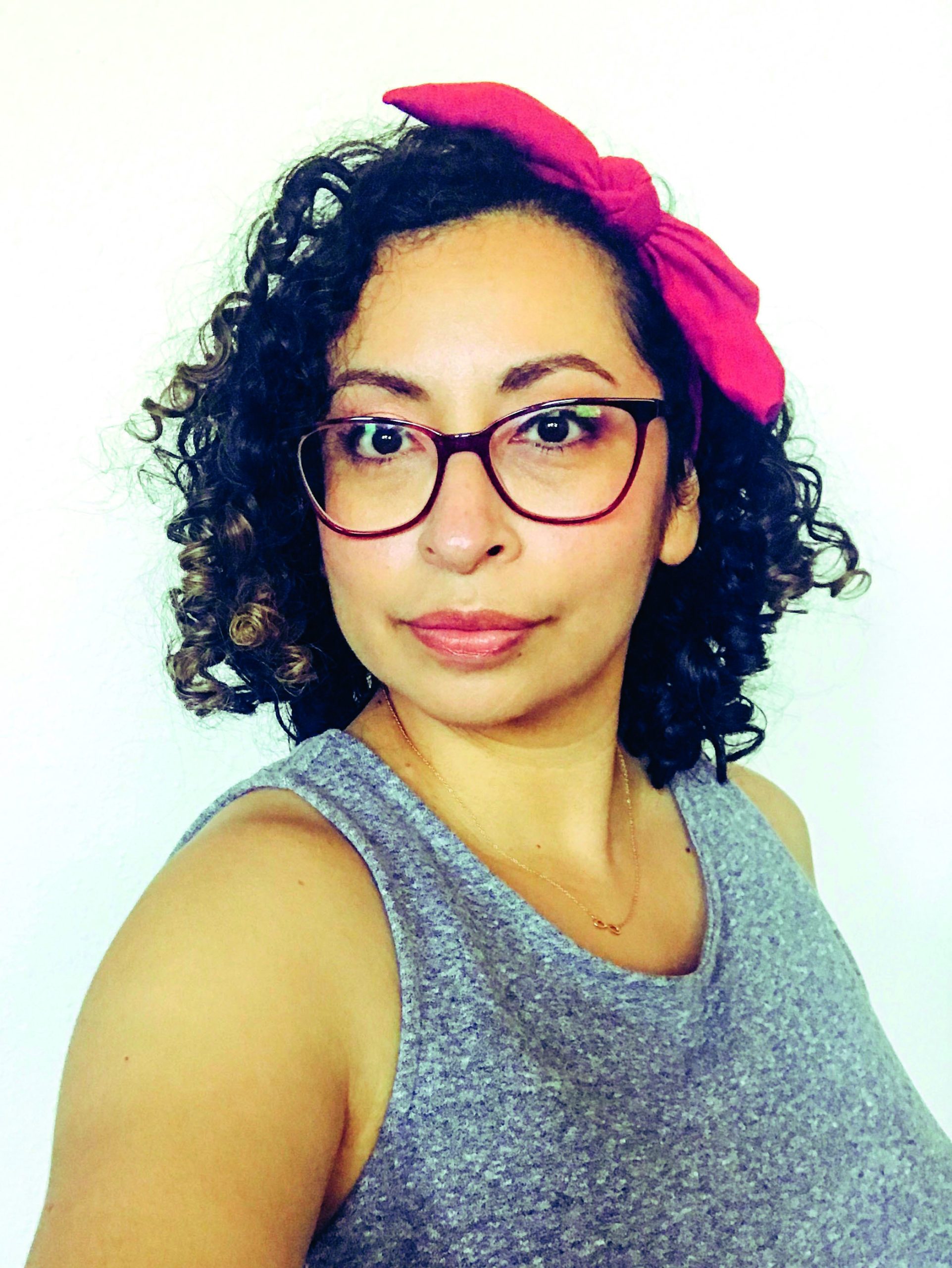
KAPLAN: How did you approach designing the characters for this adaptation? Did any character pose a particular challenge for you, or did any come together especially quickly?
PADILLA: One of the main objectives in working on this re-telling was to not only modernize the story in setting but also bring something different to its cast of characters. One of the first characters I designed was Mary and early in the process I decided to pay homage to the original work while at the same time subverting the colonial origins of the character. With that in mind I decided to make Mary bi-racial, having her father be of East Asian Indian descent. Everything else sort of grew from there, with Mary’s mother and the Cravens being Black, specifically Afro Latinx.
Interestingly enough though, it was Mrs. Medlock that posed the biggest questions for me in the design process. I didn’t want to design a stereotypical “housekeeper” so instead I leaned towards her being more of a personal assistant. This ended up being fun for me because I enjoyed decking her out in chic outfits befitting of a professional New Yorker.
KAPLAN: In addition to drawing lots of human characters, you also drew a whole lot of plants for this graphic novel! What is your process for depicting specific types of plants?
PADILLA: In all honesty this was both a component of the art that I couldn’t wait to dive into but also one that I was terrified of working on. Plants are sort of having a big moment in illustration, comics, and our overall culture right now. There are so many artists out there who are skilled at depicting plants in an effortless and aesthetically pleasing way. Unfortunately, I have a tendency to overcomplicate the gestalt of plants so trying to ensure that the garden felt beautiful and magical was something that brought me a ton of anxiety. In the end I tried to approach it like any other art challenge, utilizing plenty of reference and trying my best. I hope my efforts come across and that I managed to do the garden justice.
KAPLAN: The Secret Garden has previously been adapted to screen and stage. Is there any other adaptation of the novel that stands out to you, or has personal meaning for you?
WEIR: I haven’t seen it, but supposedly there’s an anime version that came out in the ‘90s that I’d be interested to see!
PADILLA: The 1993 film was incredibly meaningful to me. It’s beautifully art directed and I believe the house in the film is the same one used in Downton Abbey. I watched it again before I started working on the character designs and I know that played a role in how I thought of the characters. I mean come on, the film has Maggie Smith in it! Just out of curiosity I looked up some of the other adaptations and I’m interested in checking out the 70s BBC TV adaptation and just like Ivy, I’d love to see the anime version. One of my favorite parts of the original book was the Yorkshire dialect. I love how it sounds and seeing any adaptation that utilizes it is music to my ears.
KAPLAN: Is there anything else that you’d like me to include?
WEIR: Folks are welcome to reach out to me on pretty much any social platform at @ivynoelle or through my website, ivynoelleweir.com. Thank you so much for your questions!
PADILLA: I’m currently working on my first graphic novel as both writer and artist, Sugar Coated, which will be published by Scholastic Graphix in 2024. Until then you can follow me on Instagram or Twitter @candymistakes or check out my website at amberpadilla.com.
The Secret Garden on 81st Street will be available at a local bookstore or public library near you beginning on Tuesday, October 19th, 2021.


